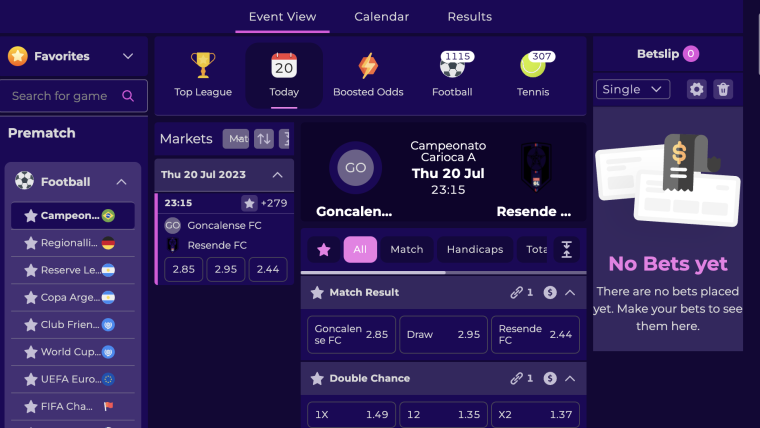Smart bankroll management in sports betting is crucial. You obviously have no control over the outcome of any sporting events. What you do have control over is the bets you place, and the amount you wager. Smartly managing both significantly improves your potential for long-term profits.
Want to learn bankroll management in sports betting to become a successful sports bettor? Read on to discover how to determine your budget, split it into individual betting units, manage your risk, and be a responsible gambler.
Understanding Sports Betting Bankroll Management

Placing sports bets at random is the quickest way to blow up your sportsbook account. Maybe you’ll get lucky, and hit a few big wins. Without any money management system in place, however, it’s more likely you’ll simply lose your bankroll, especially over the long-term.
If you’re sensibly aiming for sustainable, long-term profits as part of your sports betting strategy, you need to practice good bankroll management. If you do this right, it can literally ensure (depending on the system) that your account stays alive for a minimum predetermined amount of time.
Either way, it gives structure to your betting, and – crucially – forces you to balance risk and reward.
Here are some of the most common mistakes bettors make, which sports betting money management will help you avoid:
- Failing to adjust your stakes to the odds
- Placing a random number of wagers
- Using random stakes on your bets
- Running out of money too quickly
- Chasing after losses
Setting Up Your Bankroll
Before you can settle on a bet size for any sports bets, you need to determine your total bankroll. This must be based directly on your income.
Use the 50/30/20 method to divide your income into needs, savings, and wants. Your betting money should come from the 20%, along with things like outings, subscription services, and similar expenses. If you make $3,000 a month, for instance, you can set aside $600 for entertainment, and you might choose to allocate $400* specifically for betting.
Now you have your overall budget for bankroll betting, and can start splitting that up into individual units for wagers.
*We cannot stress enough the importance of practicing safe gambling. Only ever bet what you can afford to lose.
The Role of Unit Size
A ‘betting unit’ is simply your standard bet amount. It can be as big or small as you please, from $1 to $1,000 or more.
Knowing your unit size is important for several reasons. It serves as the base for your betting, which all your future bets will rely on. It aids in figuring out how many wagers you’ll make, how long your bankroll will endure, and more. As we’ll discuss soon, it’s also vital if you choose to use a betting system.
How Much Of Your Bankroll Should You Bet?
There’s no hard and fast rule on calculating your unit size. That said, there are a couple of guidelines you can follow.
One is that you should never, ever stake more than 10% of your total bankroll on a single wager. If your bankroll is $100, $10 should be your maximum stake size.
Another is that you should aim to split your bankroll into at least 100 betting units. This is certainly more conservative – with that $100 total, for example, it would mean $1 wagers.
Your profits will obviously be lower here. It literally guarantees, however, you get at least 100 bets out of your bankroll. This will help to negate the randomness of betting on sports, and – most notably – stop you getting taken out by a bad losing streak.
The Kelly Criterion
Kelly Betting is definitely one of the more complicated systems out there. In short, it is a mathematical formula which will tell you exactly how much to bet, on every wager you place. This formula automatically balances risk and reward for you, using the odds for that market to determine your stake size.
If you want to calculate every stake precisely, the Kelly Criterion model is perfect for you. Just know that, firstly, it involves more work than flat betting (where you simply bet the same amount every time), for example. Secondly, it will stop you from having a set unit size, and therefore make your longer-term calculations more difficult.
Setting Goals and Realistic Expectations
Your bankroll should have a direct impact on your expectations. Simply put, the amount you put in, will determine the amount you get out.
If your calculations tell you to have a $100 bankroll, then that’s what you should have. Just don’t expect to suddenly win thousands of dollars overnight. Massive wins are usually fluky and unsustainable. Instead, content yourself with steady progress which is in proportion to your budget.
Any goals you set should really be as a percentage, based on your starting bankroll. Start with $100, and you’re not going to hit $10,000 any time soon. Instead, you might target a long-term 100% profit. Getting up to $200 might not sound like the stuff of dreams, but doubling your bankroll is actually an excellent achievement.
Segmenting Your Sportsbook Bankroll
Again, one of our key aims of sports betting bankroll management is to balance risk and reward. To that end, after deciding on your budget and unit size, it can be an excellent idea to segment your bankroll.
This will help to organize your betting, and ensure you diversify nicely. Here are the three main ways to segment your gambling bankroll. Again, there’s no ‘rule’ about the actual sizes of these segments, and you can easily adjust them as you go along. Generally speaking, just make sure most of your money is going towards the ‘safer’ end of the betting spectrum.
Odds
This is the most obvious way to balance risk and reward. While we certainly advocate smart and sensible betting, this doesn’t mean always placing low-odds or super-safe wagers. This limits your potential profits too dramatically. In turn, it does help you build a cushion to sustain the losses you will eventually suffer.
Safer picks should form the bedrock of your betting. But you must also mix in longer-shots, which – when they come off – will deliver far bigger winnings.
Bet Types
This is closely related to the previous point. Rather than just taking the same bet types at varying odds, you should look to mix other bet types in too. The variety on offer here is one of the big advantages that money management for sports bettors has over slots bankroll management, for example.
Mixing your bet types will naturally give you varying odds (e.g. parlays will have higher odds than singles bets). On a personal level, however, it will both help to keep things fresh for you, and may allow you to discover new bet types which you actually prefer – and are better at using – than the usual ones.
Briefly, here are the main bet types which you’ll be using most often.
Straight Bets
These are the most straightforward wagers of all. They simply involve one outcome coming good. Money Line bets, in which you just pick the overall result of a given match up, are the most common example and popular amongst bettors looking for long-term profit.
Multiples Bets
Multiples bets – or ‘parlays’ – involve more than one selection being bundled into a single wager. All the selections must come through for your overall bet to win. Most bettors simply put multiple Money Line picks into their parlays, but you can get more control by using spread bets instead (e.g. Team X +9, Team Y -3, etc.) for optimal bankroll management.
Team vs Player Props
Team props involve just one team hitting a certain outcome. Most often, you’ll be picking one side to go over or under a particular points total. Player props, however, involve just one individual player. In NFL betting alone, you might pick someone to go over or under a certain number of yards, score a certain number of touchdowns, and so on.
Pre-Game vs In-Play
In-play betting is inherently riskier than pre-game betting when it comes to sports betting money management, since you have vastly less time to make your decisions. It does, however, also present opportunities that simply aren’t possible before kick-off. If a side is a heavy favorite pre-game, for example, then go down early in the match, you’ll often be able to grab them at far more favorable odds.
Again, we’d recommend most of your wagers being pre-game, simply for safety. Make sure you have some money set aside for those fleeting, live opportunities too, though.
Strategies to Help You Manage Risk
The bankroll management rules we’ve laid out so far should already have given you some guidance in your betting. If you want even more structure, however, you can use an actual betting system instead.
Betting systems are defined strategies which tell you how much to wager on your bets. They usually kick in after you either win or lose a bet, depending on whether they’re focused on generating profits or recouping losses, and automatically adjust your next stake for you. Do be aware, however, that these have usually been designed for casino games (such as roulette money management ). They can still work here, but only if you stick to even-odds (+100) wagers.
If you’re interested in a defined strategy for bankroll management sports betting, here are three good options.
Flat Betting
This is the most straightforward system of all. At its most basic level, it can simply involve using the same stake for every wager you place. If you decide your unit size is $5, for example, you’ll get $5 every time. If you’ve calculated your unit size carefully (as discussed earlier), your units will be small enough to get a good number of wagers out of your bankroll.
A more nuanced approach to flat betting, however, is to make your stakes a percentage of your bankroll. This means they will scale up and down depending on whether you’ve made or lost money, and keep your risk in proportion. If you decide on 5% stakes, however, then you’ll be betting $5 at a starting $100 bankroll, but $10 when you get up to $200, and so on.
Martingale System
The Martingale System is arguably the most famous betting system. It is a textbook example of negative progression betting, where the aim is to recoup any losses you’ve sustained.
In this case, you start by betting one unit. If that bet wins, you bet one unit again. If and when you lose, however, you double your next stake. Lose again, and you double again, and so on. Eventually you’ll win, and – when you do – you’ll get all your money back in one go.
The Martingale will work in theory, and is nice and simple. It can lead to your stakes ramping up very quickly, however, with the Fibonacci System being a more conservative alternative.
1-3-2-6 System
The 1-3-2-6 betting system is an example of positive progression betting. This is the profits-focused opposite of negative progression, in which your stakes are raised after a winning wager, rather than a losing one.
With the 1-3-2-6, if you lose a bet, you just bet one unit again. If you win, however, the sequence kicks in. You’ll then wager 3 units, 2 units, and 6 units respectively, if you keep winning. After that, however, the sequence is done, and you’ll start over.
The 1-3-2-6 is a nice balance between risk and reward. It has the potential for sizable profits, but – crucially – is realistic, in that you only need four wins to complete the system.
How to Adjust Your Bankroll Management Strategy
You can’t simply do all the aforementioned calculations, and have done with it. Instead, your bankroll management strategy for sports betting requires constant adjustment.
Most importantly, your levels of risk will be changing constantly as your bankroll also changes. If your starting bankroll is $100, and your starting unit size is $10, you shouldn’t still be betting $10 if you end up down to $20. Two losing wagers would wipe you out.
Likewise, however, you should also be adjusting in a positive way. If your bankroll increases, don’t be afraid to also increase your unit size. This might ‘feel’ riskier, but – in reality – your proportional risk hasn’t risen at all. Using larger stakes will also, obviously, lead to bigger potential profits.
How often should you adjust your bankroll? As often as possible. If you’re following a more complex strategy, like arbitrage betting (which can certainly deliver dependable profits, as long as you manage your stakes and budget successfully), don’t drive yourself crazy making complex calculations every single day. But the more frequently you reassess your status, and adapt your spending, the more effective your bankroll management in sports betting. At the very least, take stock of your account balance every week, and make changes accordingly.
A Few Things to Consider for Sports Bettors
By now, you should have an excellent idea of how to begin and maintain bankroll management for sports bets. Here are a few more key points to bear in mind as you go along.
⭐Responsible Gambling
It’s one thing making all the aforementioned calculations to start with. One of your biggest challenges, however, may be sticking to them. It’s imperative that you do so, however, come what may.
Chasing after losses, basing your future decisions on prior outcomes (also known as Gambler’s Fallacy), and simply ‘going with your gut’ and betting more than you can afford to lose are all bad ideas. You must stay within your budget, abide by the same segmentation, and maintain the same risk/reward balance, whatever happens.
If you find yourself struggling with this, take a break for a few days, or a week. If it’s still a problem, seek help online or in-person.
⭐Special Offers
Special offers certainly aren’t the be-all, end-all, and don’t always represent great value. The better deals out there, however, like bonus bets, really can have a significant impact on your long-term profits.
Using bonus bets and insurance (or ‘cash rebate’) offers at online betting sites can both help to save you money. Applying odds boosts or triggering winnings boosts can swell your balance. Just be sure to check the T&Cs in detail before getting involved, and check for yourself that the bonus really does represent good value.
⭐Useful Resources
The huge number of online resources out there mean that money management strategies have never been easier. There’s not only endless advice out there to guide your specific betting picks. There are also apps and tools designed to aid your bankroll management, by tracking your spending, calculating your stake sizes, and so on, many of which are completely free. Bet Analytix – available on both iOS and Android – is just one excellent example.
Excel with a Bankroll Management System
Bankroll management in sports betting might not sound exciting. There’s definitely nothing dull, however, about making more money from your gambling.
Obviously, managing your bankroll won’t have an impact on the outcomes of your actual wagers. What it will do, however, is help you to better balance your risk and reward, keep your spending in proportion to your bank balance, and – in general – practice responsible gambling.
After reading this guide, you know everything you need to in order to start managing your bankroll. To recap, begin by setting your overall budget, then identify your unit size and segment your bankroll. When you do begin betting, maintain a healthy mix of riskier and safer picks, and adjust your strategy frequently.

